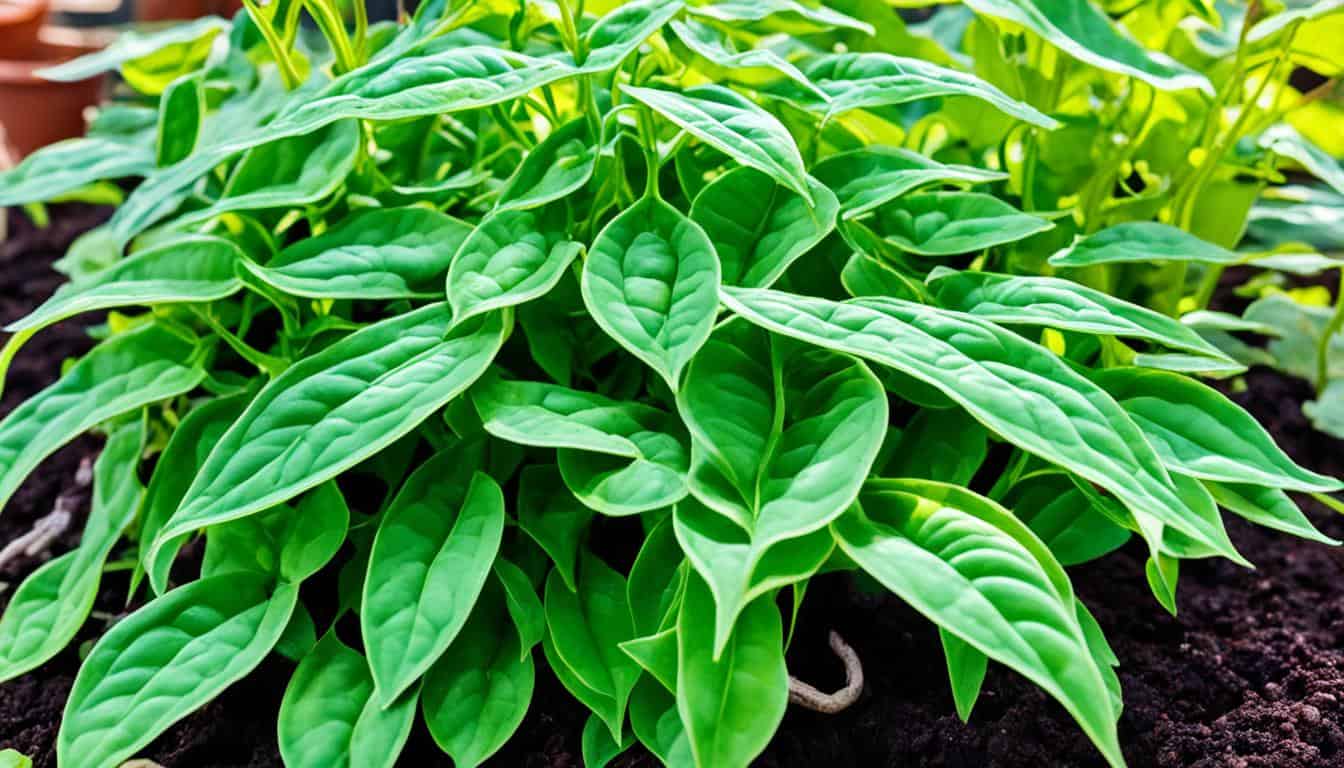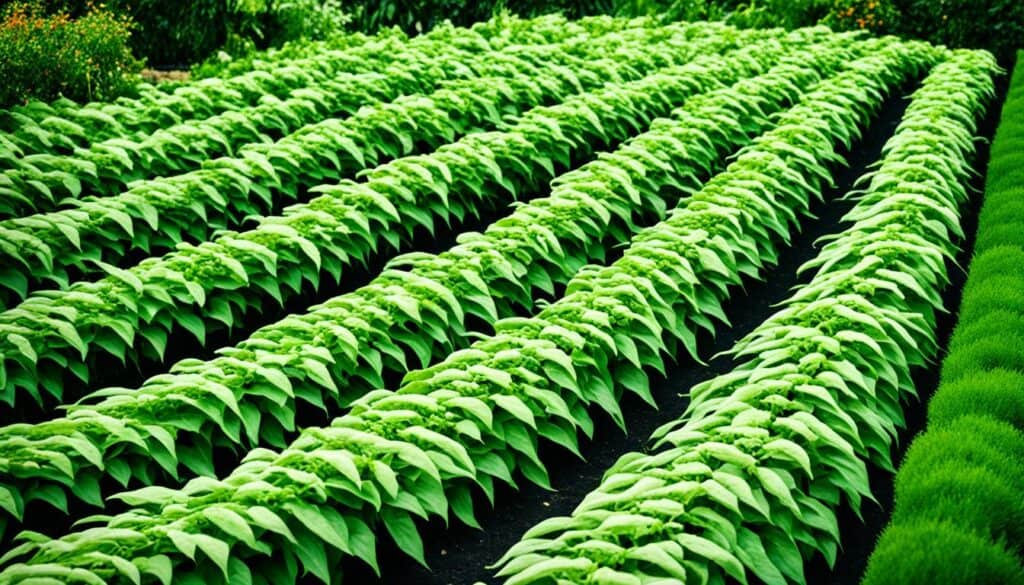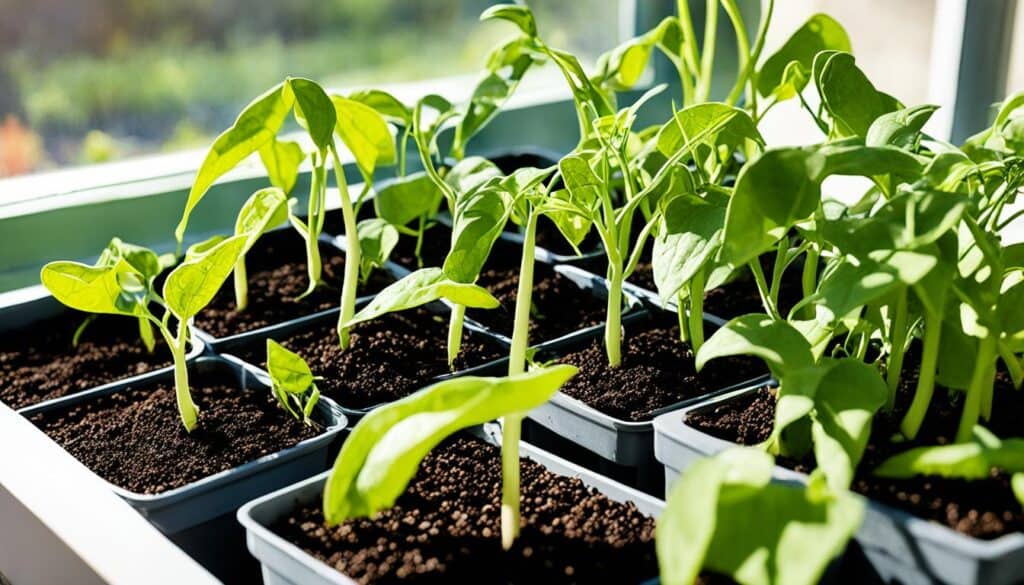Did you know that dragon tongue beans are not only delicious but also incredibly versatile? These vibrant beans, with their striking purple streaks, are a must-have in any vegetable garden. Whether you’re a seasoned gardener or just starting out, I’ve got you covered with my personal tips and tricks for growing and cooking with dragon tongue beans. Get ready to explore the world of these garden fresh gems!
Key Takeaways:
- Dragon tongue beans are a versatile addition to any vegetable garden.
- They are known for their beautiful appearance and unique flavor.
- Dragon tongue beans can be grown in various ways and used in a variety of dishes.
- Preserving dragon tongue beans opens up even more culinary possibilities.
- Including dragon tongue beans in your diet provides nutritional benefits.
About Dragon Tongue Beans
Dragon Tongue Beans are heirloom beans that were originally cultivated in the Netherlands in the 18th century. These beans have a rich history and have since been grown throughout Europe and the Americas.
One of the distinguishing features of Dragon Tongue Beans is their beautiful appearance. The pods are pale yellow with purple streaks, resembling dragon tongues, hence the name. Their unique look adds visual appeal to any vegetable garden.
Dragon Tongue Beans are highly versatile and can be grown in any vegetable garden. They thrive in various climates and growing conditions. Whether you have a backyard garden or a small urban plot, you can enjoy the benefits of these beans.
These beans are known for their hardy growth, making them relatively easy to cultivate. They can tolerate different soil types and require minimal maintenance. With proper care, you can enjoy a bountiful harvest of Dragon Tongue Beans.
When it comes to culinary applications, Dragon Tongue Beans offer a unique flavor and texture. They have a mild, nutty taste and a slightly crunchy texture. They can be used in a variety of dishes, including salads, stir-fries, soups, and stews. The possibilities are endless when it comes to cooking with Dragon Tongue Beans.
“Dragon Tongue Beans are a fantastic addition to any vegetable garden. Their striking appearance and delicious flavor make them a favorite among gardeners and cooks alike. Whether you’re a seasoned gardener or just starting out, these beans are a must-have in your garden. You won’t be disappointed!”
How to Grow Dragon Tongue Beans
Growing dragon tongue beans in your vegetable garden is a rewarding and straightforward process. With proper care and attention, you can enjoy a bountiful harvest of these delicious beans. Here are some essential steps to get you started:
Soil Preparation
Dragon tongue beans prefer well-draining soil that is rich in organic matter and has a neutral pH level. Before sowing the seeds, prepare the soil by removing any weeds or debris. Loosen the soil to a depth of 8-10 inches and mix in compost or well-rotted manure to improve its fertility. This will provide the beans with the nutrients they need to thrive.
Planting
Once the last frost has passed and soil temperatures reach around 65°F, you can directly sow the dragon tongue bean seeds in your garden. Plant the seeds about 1 inch deep and 3 inches apart, with rows spaced around 18 inches apart to allow for proper airflow and growth.
Alternatively, you can start the seeds indoors 2-3 weeks before the last frost and transplant the seedlings into your garden once they have developed a strong root system.
Watering
Proper watering is crucial for the growth of dragon tongue beans. Keep the soil evenly moist, but not waterlogged, throughout the growing season. Depending on the weather conditions, you may need to water the plants 1-2 times per week. Mulching around the plants can help retain moisture and prevent weed growth.
Remember to adjust the watering frequency during hot and dry periods to ensure the beans receive adequate hydration.
Care and Maintenance
As the dragon tongue beans grow, provide them with support such as trellises or stakes to keep the vines upright. This will minimize the risk of diseases and pests, and also make harvesting easier. Regularly check the plants for any signs of pests or diseases, such as bean beetles or fungal infections, and take appropriate action to protect your crop.
Additionally, consider applying a balanced organic fertilizer once the plants begin to flower to promote healthy growth and abundant bean production.
Dragon tongue beans typically mature in approximately 60 days, and you can start harvesting them once the pods reach a length of 6-7 inches. The beans can be harvested throughout the season to enjoy their fresh flavor and texture.
Embrace the joy of growing your own dragon tongue beans. With these tips, you’ll be well on your way to a thriving vegetable garden filled with these flavorful and nutritious beans.
Where to Get Dragon Tongue Beans
If you’re looking to get your hands on some delicious dragon tongue beans, look no further than Seeds for Generations. As a small family-owned business, they specialize in heirloom garden seeds, including the coveted dragon tongue beans.
Seeds for Generations prides itself on providing high-quality seeds that are perfect for garden enthusiasts and vegetable lovers alike. They offer a wide range of heirloom varieties, ensuring that you have plenty of options to choose from.
By purchasing your dragon tongue beans from Seeds for Generations, you not only get access to top-notch seeds but also support sustainable agriculture and the preservation of heirloom plants. It’s a win-win situation!
Start your dragon tongue bean journey with Seeds for Generations and taste the difference that heirloom seeds can make.
| Why Choose Seeds for Generations? | Benefits of Seeds for Generations |
|---|---|
| Wide selection of heirloom seeds | Supports sustainable agriculture |
| Rigorous quality control | Promotes seed preservation |
| Family-owned and operated | Ensures genetic diversity |
When to Harvest Dragon Tongue Beans
Harvesting dragon tongue beans at the right time is crucial to ensure the best flavor and texture. Here are some tips to help you determine when to harvest your beans:
- Dragon Tongue Beans can be harvested when they are about 6-7 inches long for fresh eating. At this stage, they are tender, crisp, and delicious.
- The pods start off green and develop purple streaking as they mature, giving them their distinctive appearance. This color change is a good indication that the beans are ready to be picked.
- If you prefer to use dragon tongue beans as shelling beans, you can leave them on the vine until they dry out and the pods turn brown. The beans inside will be fully developed and can be shelled for later use.
Whether you prefer fresh beans or shelling beans, it’s important to harvest them regularly to encourage continued production. Harvesting the beans stimulates the plant to produce more pods, allowing you to enjoy a bountiful supply throughout the season.
These fresh and vibrant dragon tongue beans are perfect for adding a pop of color to your garden and recipes. Whether you enjoy them straight from the vine or use them in your favorite dishes, you’ll love the unique flavor and versatility they bring.
| Harvesting Tips | Fresh Beans | Shelling Beans |
|---|---|---|
| Harvest when the beans are about 6-7 inches long. | Harvest when the pods turn brown and dry out. | |
| Look for green pods with purple streaking. | Shell the beans and store them in a cool, dry place. | |
| Harvest regularly to encourage continuous production. | Use shelling beans in soups, stews, and other recipes. |
How to Preserve Dragon Tongue Beans
Preserving dragon tongue beans is a great way to enjoy their delicious flavor all year round. Whether you have a surplus of beans from your garden or want to stock up during the harvest season, there are several preservation methods to choose from. Let’s explore the three popular methods: canning, freezing, and pickling.
Canning Dragon Tongue Beans
Canning is a classic preservation technique that allows you to store dragon tongue beans for an extended period. Here’s how you can do it:
- Start by washing and trimming the beans, removing any imperfections.
- Sterilize your canning jars and lids following the manufacturer’s instructions.
- Boil the beans in a large pot of water for a few minutes to blanch them.
- Transfer the beans to the sterilized jars, leaving about an inch of headspace.
- Add your preferred seasoning or brine to the jars, ensuring the beans are fully submerged.
- Seal the jars with the lids and process them in a boiling water bath for the recommended time.
- Allow the jars to cool, then store them in a cool, dark place for future use.
Canned dragon tongue beans can be delicious when added to soups, stews, or served as a side dish.
Freezing Dragon Tongue Beans
Freezing is a simple method to preserve the flavor and texture of dragon tongue beans. Follow these steps to freeze your beans:
- Wash and trim the beans, removing any blemishes.
- Blanch the beans in boiling water for a couple of minutes, then transfer them to an ice bath to cool quickly.
- Drain the beans and pat them dry.
- Spread the beans in a single layer on a baking sheet and place them in the freezer until frozen.
- Transfer the frozen beans to freezer-safe bags or containers, removing any excess air.
- Label the bags or containers with the date and freeze for up to 8-12 months.
Frozen dragon tongue beans are perfect for stir-fries, casseroles, or as a side dish.
Pickling Dragon Tongue Beans
Pickling dragon tongue beans adds a tangy and flavorful twist to their natural taste. Here’s how you can pickle your beans:
- Wash and trim the beans to your desired size.
- Prepare a brine solution by combining vinegar, water, salt, and your choice of spices.
- Bring the brine to a boil, then reduce the heat and let it simmer for a few minutes.
- Place the beans in sterilized jars, leaving some headspace.
- Pour the hot brine over the beans, ensuring they are fully submerged.
- Seal the jars with lids and let them cool to room temperature.
- Refrigerate the jars for at least 24 hours to allow the flavors to develop.
Pickled dragon tongue beans make a tasty addition to salads, antipasto platters, or as a zesty snack on their own.
By canning, freezing, or pickling your dragon tongue beans, you can enjoy their fresh taste and nutritional benefits long after the harvest season has ended. Choose the preservation method that suits your preferences and enjoy a taste of summer all year round!
Dragon Tongue Beans in Recipes
Dragon Tongue Beans are not only visually appealing but also incredibly versatile in the kitchen. Their mild, nutty flavor makes them a delightful addition to a wide range of dishes. From sautéing to pickling, there are countless ways to incorporate these vibrant beans into your culinary creations.
Sautéed Dragon Tongue Beans
Sautéing dragon tongue beans brings out their natural flavors and adds a delightful crispness to each bite.
Heat a drizzle of olive oil in a skillet over medium heat.
Add the dragon tongue beans and cook for 5-7 minutes, stirring occasionally, until they are tender but still retain their vibrant green color.
Season with salt and pepper to taste, and enjoy as a simple and delicious side dish.
Dragon Tongue Bean Salad
A refreshing and colorful salad that showcases the beauty of dragon tongue beans.
In a large bowl, combine blanched dragon tongue beans, cherry tomatoes, red onions, and feta cheese.
Drizzle with a tangy vinaigrette made with lemon juice, olive oil, Dijon mustard, and honey.
Toss to coat the ingredients evenly and serve as a refreshing salad on a hot summer day.
Dragon Tongue Bean Stir-Fry
A quick and flavorful stir-fry that combines dragon tongue beans with an array of vegetables and a savory sauce.
Heat a tablespoon of sesame oil in a wok or large skillet over high heat.
Add sliced bell peppers, snap peas, carrots, and dragon tongue beans.
Sauté for a few minutes until the vegetables are crisp-tender.
In a small bowl, whisk together soy sauce, ginger, garlic, and a pinch of red pepper flakes.
Pour the sauce over the vegetables and stir-fry for an additional 2-3 minutes.
Serve over rice or noodles for a satisfying and flavorful meal.
Pickled Dragon Tongue Beans
A tangy and zesty twist on dragon tongue beans that adds a burst of flavor to any dish.
In a saucepan, combine equal parts white vinegar and water.
Add sugar, salt, whole cloves, and mustard seeds.
Bring the mixture to a boil, then reduce the heat and simmer for 5 minutes.
Place the trimmed dragon tongue beans in sterilized jars and pour the hot pickling liquid over them.
Seal the jars tightly and let them cool to room temperature.
Refrigerate for at least 24 hours before enjoying the tangy pickled beans on sandwiches, salads, or charcuterie boards.
Dragon Tongue Bean Casserole
A hearty and comforting casserole that showcases the rich flavors and textures of dragon tongue beans.
Preheat the oven to 350°F (175°C).
In a large skillet, sauté onions, garlic, and diced bell peppers until softened.
Add cooked, chopped bacon, sliced mushrooms, and blanched dragon tongue beans.
In a separate bowl, whisk together cream, eggs, grated cheese, salt, and pepper.
Pour the mixture over the vegetable and bacon mixture in the skillet and stir to combine.
Transfer the mixture to a greased casserole dish and bake for 25-30 minutes, or until it is golden and bubbling.
Allow it to cool for a few minutes before serving this delicious casserole as a main dish or a satisfying side.
These are just a few examples of the culinary possibilities that dragon tongue beans offer. Their unique appearance, versatility, and mild flavor make them a delightful addition to any recipe. Whether you sauté, stir-fry, pickle, or bake them, these colorful beans are sure to elevate your culinary creations to new heights.
Nutritional Benefits of Dragon Tongue Beans
Dragon Tongue Beans offer several nutritional benefits. They are a good source of plant-based protein and are rich in dietary fiber. They also contain essential vitamins and minerals, including folate, iron, and potassium. Including dragon tongue beans in your diet can contribute to overall health and well-being.
Nutritional Composition of Dragon Tongue Beans
| Nutrient | Amount per 100g |
|---|---|
| Protein | 8g |
| Dietary Fiber | 6g |
| Folate | 40mcg |
| Iron | 2.5mg |
| Potassium | 200mg |
As legumes, dragon tongue beans are not only a great source of plant-based protein but also high in fiber. Protein is essential for tissue repair and growth, while fiber aids in digestion and helps maintain a healthy gut. Additionally, dragon tongue beans contain folate, which plays a crucial role in cell function and development, particularly during pregnancy. Iron is important for red blood cell production and oxygen transport, while potassium helps maintain proper blood pressure and heart function.
Dragon Tongue Beans are a nutritional powerhouse! Their combination of protein, fiber, and essential vitamins and minerals makes them a valuable addition to any diet.
Incorporating dragon tongue beans into your meals can provide a range of health benefits. Whether you enjoy them as a side dish, in salads, or as a main ingredient in recipes, these nutritious beans can support your overall well-being and contribute to a balanced diet.
Growing Dragon Tongue Beans in Containers
Dragon Tongue Beans are not only suitable for traditional gardens but can also be grown in containers, making them a perfect option for those with limited space or urban gardens. Growing dragon tongue beans in containers allows you to enjoy their unique flavor and beautiful appearance, right on your balcony or patio.
To successfully grow dragon tongue beans in containers, here are a few simple steps to follow:
- Choose containers with good drainage: Select containers that have drainage holes at the bottom to prevent waterlogging. This will ensure that the roots don’t rot and the plants thrive.
- Use well-draining potting mix: Fill the containers with a high-quality potting mix that provides good drainage. Avoid using regular garden soil as it can become compacted in containers, hindering proper root growth.
- Sow the seeds: Plant the dragon tongue bean seeds in the container, following the same spacing recommendations as you would in a garden. Typically, sow the seeds about 1 inch deep and space them 4-6 inches apart.
- Provide adequate sunlight: Place the containers in a location that receives full sun for at least 6-8 hours a day. Dragon tongue beans require plenty of sunlight to grow and produce a bountiful harvest.
- Water regularly: Keep the soil evenly moist by watering the plants regularly. Containers tend to dry out faster than garden beds, so make sure to check the moisture level frequently and water as needed.
With proper care and maintenance, your dragon tongue beans will thrive in containers and reward you with a plentiful harvest of delicious beans. Whether you have a small balcony or a sunny windowsill, container gardening allows you to enjoy the joys of growing your own food.
Container gardening offers a convenient and practical way to cultivate dragon tongue beans in any available space. Not only will you have a fresh supply of dragon tongue beans for your culinary adventures, but the vibrant green foliage and purple-streaked pods will also add a touch of natural beauty to your living space.
The Versatility of Dragon Tongue Beans
One of the great things about dragon tongue beans is their versatility. These beans offer a wide range of cooking options, making them a valuable ingredient in any kitchen.
Diverse Cooking Options
Dragon tongue beans can be enjoyed in various ways, allowing you to explore new culinary horizons. Here are some popular cooking methods:
- Fresh Snap Beans: These beans can be harvested young and enjoyed as fresh snap beans. Their crisp texture and delicate flavor make them a delightful addition to salads, stir-fries, or as a colorful side dish.
- Canned or Frozen: To preserve the flavors of dragon tongue beans for later use, you can opt for canning or freezing. By canning them, you can enjoy their taste all year round. Freezing is another convenient option that maintains their flavor and texture, allowing you to savor them even during the off-season.
- Shelling Beans: If you prefer a heartier dish, you can allow the dragon tongue beans to fully mature on the vine. Once dry, shell the beans and use them in recipes that call for shelling beans, such as soups, stews, or casseroles. The creamy texture and unique appearance of the beans will add depth and visual appeal to your dishes.
The versatility of these beans allows you to experiment in the kitchen and discover new flavors and textures. Their vibrant colors and distinctive shape can elevate the visual appeal of any dish, making them a favorite among professional chefs and home cooks alike.
To further illustrate the diverse uses of dragon tongue beans, here is a beautiful table showcasing their various cooking options:
| Cooking Method | Description |
|—|—|
| Fresh Snap Beans | Enjoy the crisp and delicate flavor of young dragon tongue beans in salads, stir-fries, or as a tasty side dish. |
| Canned or Frozen | Preserve the flavors of dragon tongue beans by canning them for long-term use or freezing them for enjoyment during the off-season. |
| Shelling Beans | Allow the beans to mature and dry on the vine, then shell and use them in hearty dishes like soups, stews, and casseroles. |
“Dragon tongue beans add a vibrant touch to any dish, be it a fresh summer salad or a hearty winter stew. Their versatility knows no bounds, opening up a world of culinary possibilities.”
With such cooking options at your disposal, dragon tongue beans are sure to inspire creativity in the kitchen and excite your taste buds.
Tips for Growing Healthy Dragon Tongue Beans
To ensure healthy growth of dragon tongue beans in your vegetable garden, it is crucial to implement effective pest management strategies and provide proper soil preparation. By following these tips, you can optimize the growing conditions for your dragon tongue beans and maximize their productivity.
Pest Management
Pests, such as bean beetles, can pose a threat to your dragon tongue beans. To protect your plants, consider using row covers. These covers act as a physical barrier, preventing pests from reaching your beans. Additionally, you can employ organic pest control methods if needed.
“Row covers are a great way to safeguard your dragon tongue beans from pests. They create a barrier that effectively keeps bean beetles and other insects at bay.”
Soil Preparation
Proper soil preparation is vital for the healthy growth of dragon tongue beans. Start by selecting a well-draining soil that is rich in organic matter. This type of soil provides the necessary nutrients and moisture retention for robust plant development. Aim for a neutral pH level, as dragon tongue beans thrive in this range.
Prior to planting, incorporate compost or well-rotted manure into the soil to improve its fertility. This will ensure that your dragon tongue beans have access to the essential nutrients they need to flourish.
Regular Watering
Dragon tongue beans require regular watering to maintain optimal growth and productivity. Keep the soil consistently moist but avoid overwatering, as excessive moisture can lead to root rot and other issues. Aim for a balance by providing sufficient water without saturating the soil.
It is also beneficial to use mulch around the base of the plants to conserve moisture, suppress weeds, and maintain a more stable soil temperature.
| Pest Management Tips | Soil Preparation Tips | Watering Tips |
|---|---|---|
|
|
|
Conclusion
In conclusion, growing dragon tongue beans in your vegetable garden is a rewarding experience. These heirloom beans offer a unique visual appeal with their vibrant colors and can be used in a variety of culinary creations. Whether you enjoy them fresh, canned, or pickled, dragon tongue beans provide a delicious and nutritious addition to your meals.
By following the tips and tricks outlined in this article, you can successfully grow dragon tongue beans and maximize their potential in your kitchen. From proper soil preparation to effective pest management, every step contributes to a bountiful harvest.
Remember to choose high-quality seeds from reputable sources such as Seeds for Generations, ensuring the authenticity and sustainability of your crop. With their versatility in cooking and nutritional benefits, dragon tongue beans are an excellent choice for any garden enthusiast.
So, go ahead and plant dragon tongue beans in your garden today. Embrace the beauty, flavor, and abundance they bring, and enjoy the many culinary adventures that await you. Happy gardening and cooking!










Leave a Reply